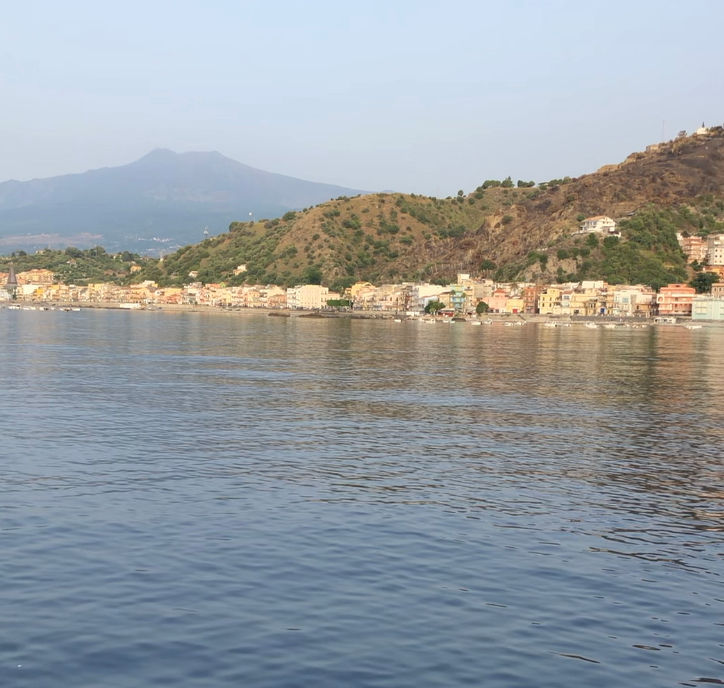
Mount Etna from the place we anchored overnight
Gentle breeze this morning. The water is almost flat. Coffee on the back of the boat is delightful as always. We reached Taormina last night and plan to visit the town up the hills at half ten. The town always puzzled me since I cannot reconcile its history with its size. To me the town looks like the typical medieval hill-town. Its location and the high walls protect the people against pirates. Except that it is not. Medieval people did not build 5’000 seat theaters – only Greek settlers did that.

View from Taormina towards Naxos, the ancient Greek town
Below Taormina, at the mouth of the river Alcantara, there once was the ancient Greek colony of Naxos. It was Sicily’s first colony, established in 735 BC, by settlers from Chalcis. Naxos was one year older than its main rival further south, Syracuse. Naxos prospered and within a few years established daughter-colonies further south in Catana and Lentini.

Map of the Peloponnesian War 431 - 403 BC showing the disastrous Athenian Expedition\
But Naxos did not survive. Were it not for the 19th century monument in the harbour, we would most likely not know where it was. During the Peloponnese war, Naxos sided with Athens. After the Athenian Fleet was destroyed, Syracuse took revenge and erased Naxos. No stone remained standing. Its people were enslaved and scattered. As I said yesterday, the highly cultured Greeks could be utterly cruel.

The modern Monument for Naxos in the harbour of Schiso
The theatre of Taormina and Naxos date from the same time. Often people use the names of Naxos and Taormina interchangeably. Wonder whether wealthy Greeks from Naxos had villas in the northern hills to benefit from the sea breeze during the hot summer months. Or was Taormina Naxos’ Acropolis? Greek theatres were never built alone. They were part of public life and built within a complex of temples, altars, and other religious buildings. In Syracuse they all stand next to each other. So they do in Epidaurus and Athens.

Today the Ancient Theatre has 3'000 seats and is used for Live Performances in summertime
Never heard of big temples and altars in Taormina though. Nor of fortifications which protect all the Acropolis in other places . Nor of nearby Greek villas. My only evidence is the absence of an Acropolis in Naxos – but there are no Greek towns without an Acropolis.

Red = Ancient Greek & Roman Buildings ; Purple = Medieval town with Castle
Be it as it may, I won’t be able to solve this puzzle today. When the Roman slaves rebelled in Sicily in the 1st century BC, they immediately recognised the strong position of Taormina and occupied it. It is one of the towns they held longest against the Roman legions. The same can be said of the Normans who loved it for its strategic position. And when the Spanish eventually took over, they liked it for all the above reasons as well. It was easy to defend against the threat of Muslim pirates.

Taormina has now a distinctive Spanish Look and Feel - the Spanish owned it for 7 centuries
What the Romans actually did there is not so clear to me again. We know that they doubled the size of the theatre. As a rule of thumb, a theatre was built for about 5% of a town’s population. But where were these 200’000 Romans living? Gets me back to the first puzzle!

Painting of Taormina for the Gentlemen interested in a Grand Tour (no Ladies ?)
Life in Taormina was quiet until it was discovered by young European nobles who were on their Grand Tour to Greece. Wolfgang Goethe, the German poet, was one of them. But these youngsters were few. All changed with the arrival of the steam engine, large cruise ships and railways. In the first decade of the 20th century, Taormina became a cult center for gay men who acted as trend setters for modern tourism. The two world wars interrupted this development, but word of Taormina’s beauty spread with the British 8th Army who liberated it in 1943.

Taormina's Beauty always pulls a Crowd! Then and Now!\
Since then, Taormina has a firm place in the agenda of English and North American visitors. It is one of the “must see” in Sicily. We heard quite a lot of American English when in town today. With their vaccination program well advanced, the Americans are the first to return.

The Number of Luxury Shops are the best Evidence of
How much Taormina is still in Demand today
After our visit we set sail (actually started the engine) and left for Reggio di Calabria to refuel and then to head for the Aeolian Islands. We want to pass through the Straits of Messina before sunset and reach Lipari tonight. One of the obstacles were the refuelling procedures in Reggio. It takes seven officials to get fuel - one working, six supervising... But Covid money from Germany will solve he issue - am sure!

Sailing past Scilla where once the Monster lured sailors
into a trap before the Spanish built a fort on the rock
Sailing through the turbulences in the Straits is quite an experience. We were on autopilot but had to keep the boat manually on course. The currents are so strong that the boat is easily swept left and right without correcting action. Wonder what Greek and Roman sailors did who depended entirely on wind. These Straits are devilish to sail. The Legend of Scylla and Charybdis was not born without reason.

The Sun was setting when we passed the Straits of Messina - we were just on time
Comments